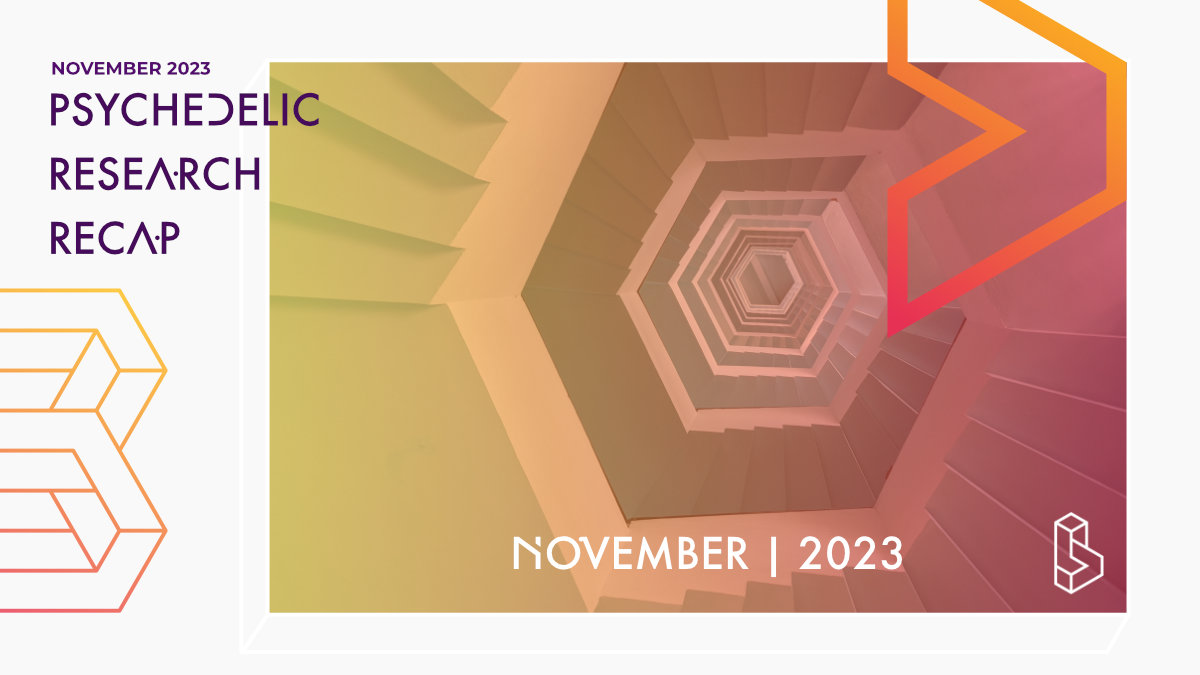This November, we saw promising developments across various areas of psychedelic research. To start, an innovative study explored novel routes of administering ayahuasca-analogue compounds, potentially improving tolerability. Additionally, several surveys shed light on the impacts of psychedelic experiences on measures like alcohol use and spiritual well-being.
We also saw advances in unravelling the complex mechanisms of classic psychedelics and their therapeutic metabolites. Beyond pharmacology, perspectives were offered on providing post-trial care provisions for psychedelic study participants. Quantitative analysis revealed insights into first-time ayahuasca experiences in depressed individuals.
In November, 14 articles were added to the database (inching us ever closer to 2000 articles), from epidemiological insights to tracking psychedelic states via heart rate dynamics.
In this recap, I’ll highlight findings across pharmacokinetics, substance use disorders, adverse reactions, and mechanisms of action.
Check out the monthly link overview for all studies that we didn’t add to the database.
Ayahuasca Enters Clinical Trials
This first-in-human pilot study tested novel DMT and harmine formulations to overcome the limitations of traditional ayahuasca. Oral administration induced fewer side effects than botanical ayahuasca but showed high interindividual pharmacokinetic variability in absorption. The unpredictable dose-response relationship and subjective effects cast doubt on meeting regulatory standards for clinical use.
However, combined intranasal DMT with buccal harmine yielded substantially improved pharmacokinetic profiles. The approach demonstrated more predictable systemic exposure and was well-tolerated. Allowing self-titration of repeated nasal DMT puffs promoted safety and tolerability. While expectation effects remain, the method appears valuable for future psychiatric research. Overall, bypassing oral administration significantly enhanced precision, consistency, and acceptability – making way for translational ayahuasca research. In other words, this research could be the first step towards making ayahuasca more suitable as a medicine within the Western paradigm.
An interview study helps further examine ayahuasca’s subjective effects on first-time users. The quantitative analysis of self-reports from depressed patients and healthy controls identified five categories of experiences. These included altered consciousness, cognitive changes, bodily reactions, and audiovisual phenomena. Notably, individuals with depression reported more negative somatic effects. The study highlights subjective axes of psychedelic experiences that could inform therapeutic approaches.
The final ayahuasca study gathered perspectives from ayahuasca ceremony leaders on special considerations for participants with eating disorders. The analysis identified screening procedures, managing purging/diets, assessing risks, and integrating with conventional treatment. Findings emphasized careful screening and support to promote safe, beneficial experiences for this population. As ayahuasca use increases globally, developing knowledge on these topics is pressing yet complex.
Psychedelic Survey Studies in November 2023
This month featured several noteworthy survey studies investigating the impacts of naturalistic psychedelic use across dimensions of substance use, spirituality, and mental health.
First, a retrospective online survey found psychedelic experiences were associated with reduced alcohol consumption and dependency. Subjects reporting improvements initially had more severe alcohol use disorder and lower psychological flexibility. Changes correlated with mystical experience intensity and increased flexibility afterwards.
Another cross-sectional survey assessed the Spiritual Well-Being Scale among psychedelic users and non-users. The analysis found religious well-being showed superior reliability and validity compared to existential well-being. Intriguingly, spiritual well-being followed a U-shaped curve regarding psychedelic use frequency (those with no or frequent use both scored better on the well-being scales than those with infrequent use).
Finally, an online survey of over 800 Norwegian adults revealed primarily recreational (46%) or therapeutic (42%) motivations for memorable psychedelic experiences. Most reported improvements in self-perceived mental health conditions despite adverse reactions in a subset.
Together, these surveys demonstrate promise but also risks of naturalistic psychedelic use.
This research recap is made possible by Blossom’s members
Support psychedelic research by joining Blossom
Reviewing the Vast Universe of Psychedelic Research
This month featured insights into the complex pharmacology of ibogaine for treating substance use disorders. One review examined its modulation of multiple addiction-related targets, emphasizing a multi-target approach given its actions on opioid, serotonin, NMDA, and other receptors.
Additionally, a scientometric analysis tracked ibogaine publications over 30 years, revealing rising interest and evolving focus – from cocaine and alcohol initially to opioids and psychedelics more recently.
In other developments, a mini-review explored classic psychedelics like psilocybin and LSD, looking beyond their primary 5-HT2A agonism at interactions with 5-HT1A, 5-HT2C, and neurotrophin receptors. It highlighted pursuing non-hallucinogenic derivatives and roles in protein modification.
Additionally, a systematic review investigated psychedelic interactions with drugs like antidepressants, antipsychotics, and recreational substances. Effects ranged from attenuated to potentiated, emphasizing the need to elucidate underlying pathways (especially if psychedelics want to be used as licensed medicines, the interactions with many common medications are still relatively unknown).
Tracking Psychedelic States
This month also featured insights into tracking psychedelic states via physiological and neuroimaging metrics. One preprint introduced a Bayesian framework assessing heart rate dynamics across psychedelics like DMT and ketamine. It revealed consistent increases in heart rate variability and entropy, relating to subjective effects and complementary to brain signals.
Additionally, a reanalysis of psilocybin data found functional connectomes became more individualized under the drug. Isolating default mode network patterns predicted subjective drug experiences characterized by altered within-network and between-network connectivity.
What you can find on Blossom
This month, we’ve added 14 studies to the database of 1986 research publications. As we near the end of the year, we expect to feature 2000 psychedelic research articles before the end of December.
If you enjoy Blossom, please subscribe to our weekly psychedelic research newsletter. Join us with any level of membership to browse the website without limits.
Become a psychedelic insider
Get a Pro Membership to enjoy these benefits & support Blossom📈 full reports on Topics & Compounds
🧵 full summary reviews of research papers
🚀 full access to new articles
See Memberships

